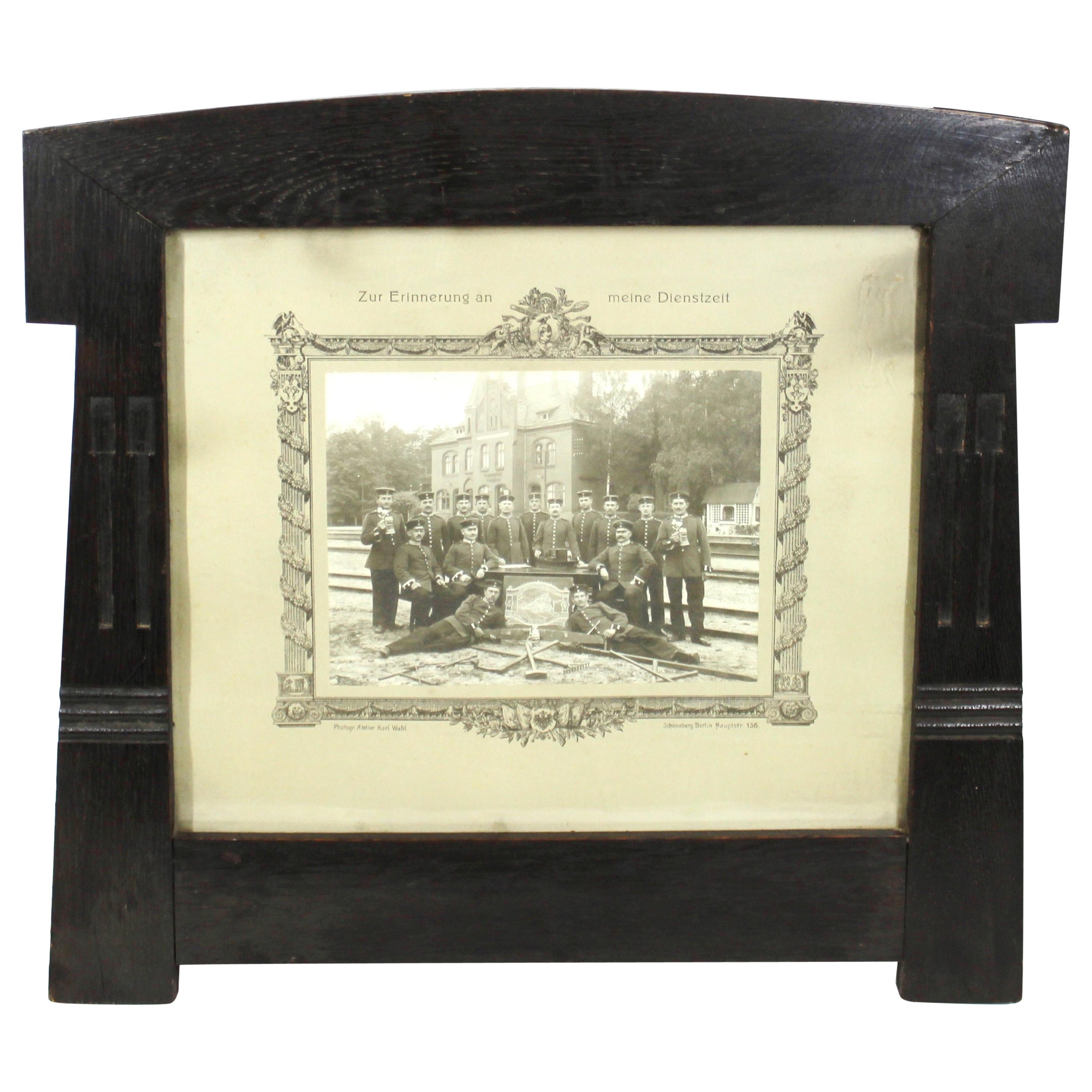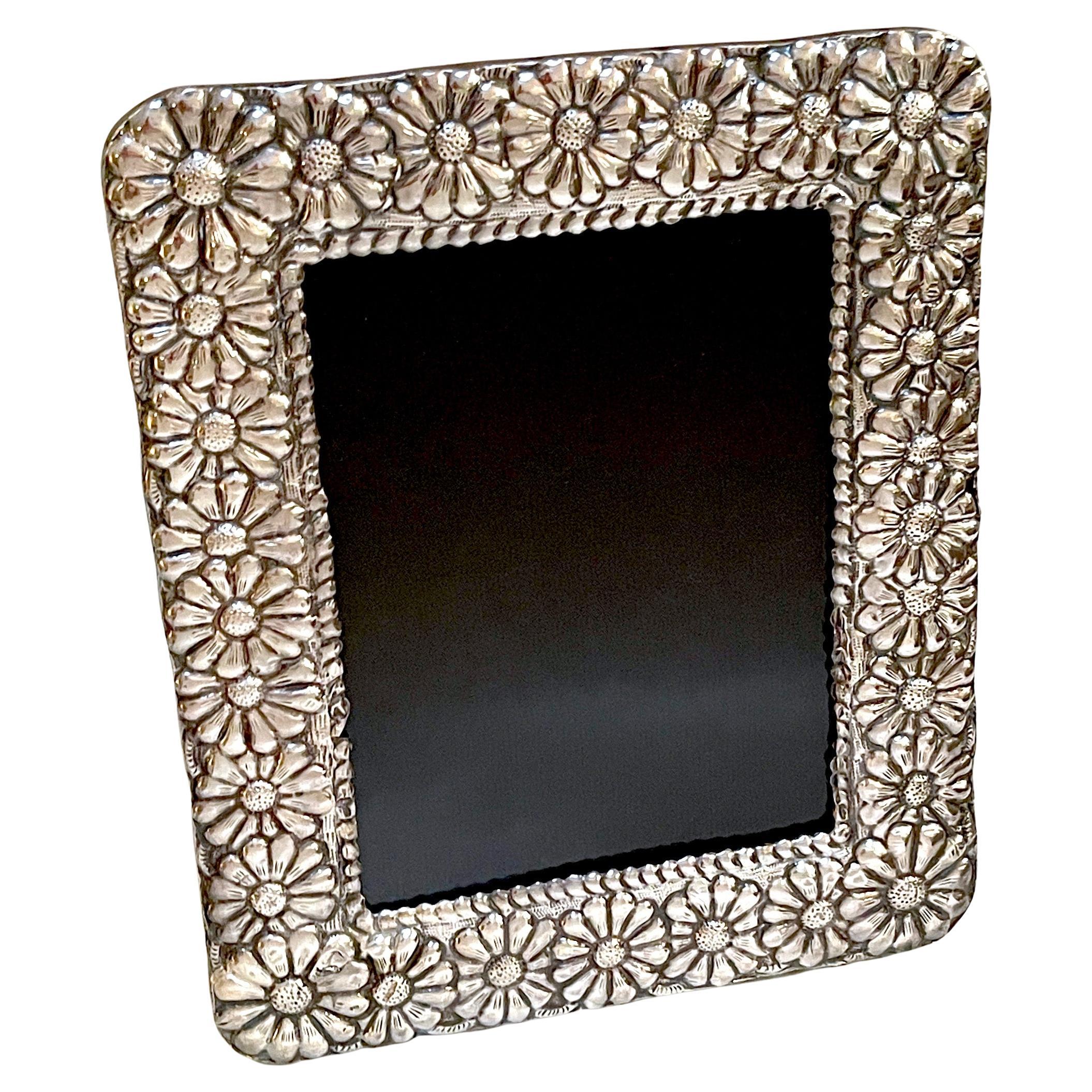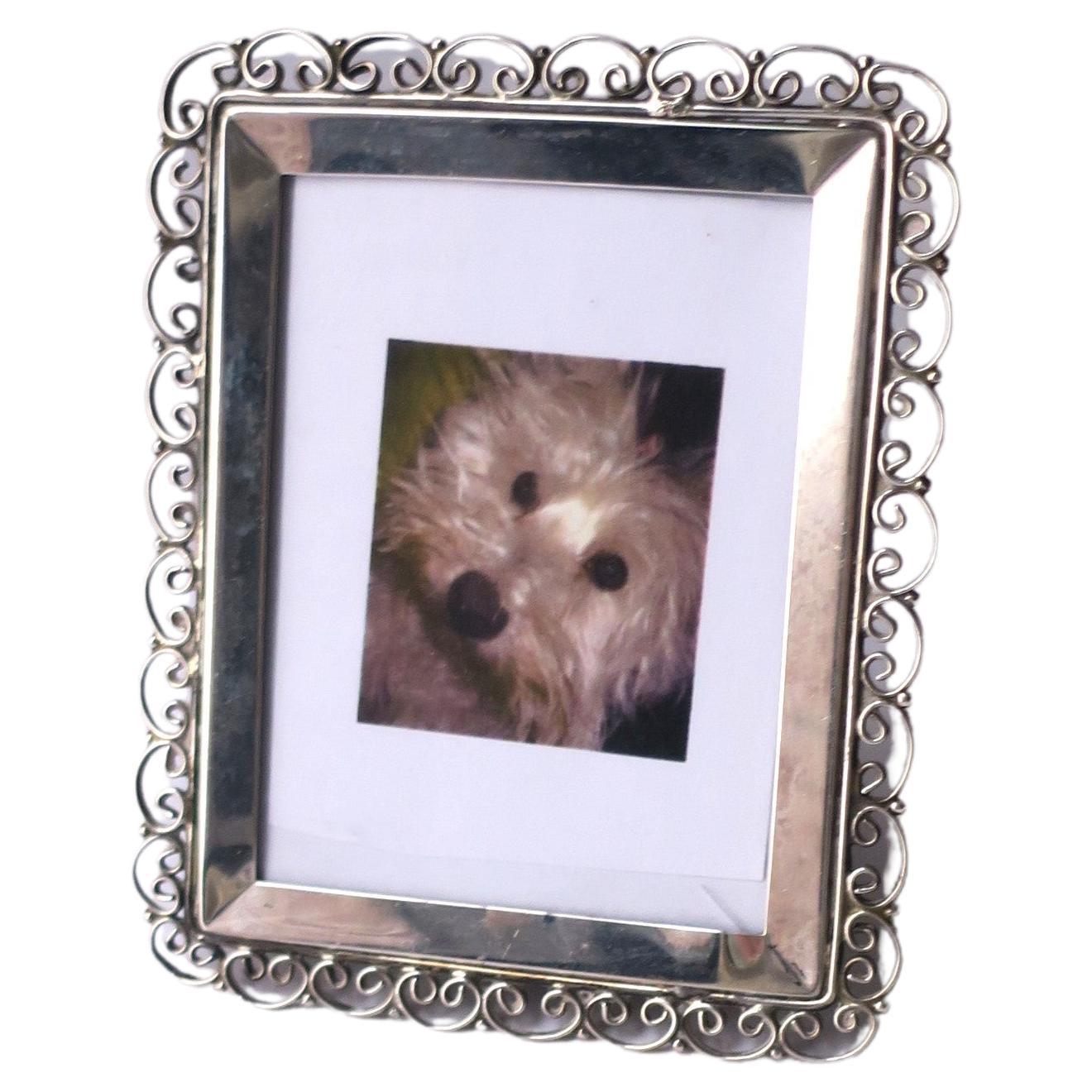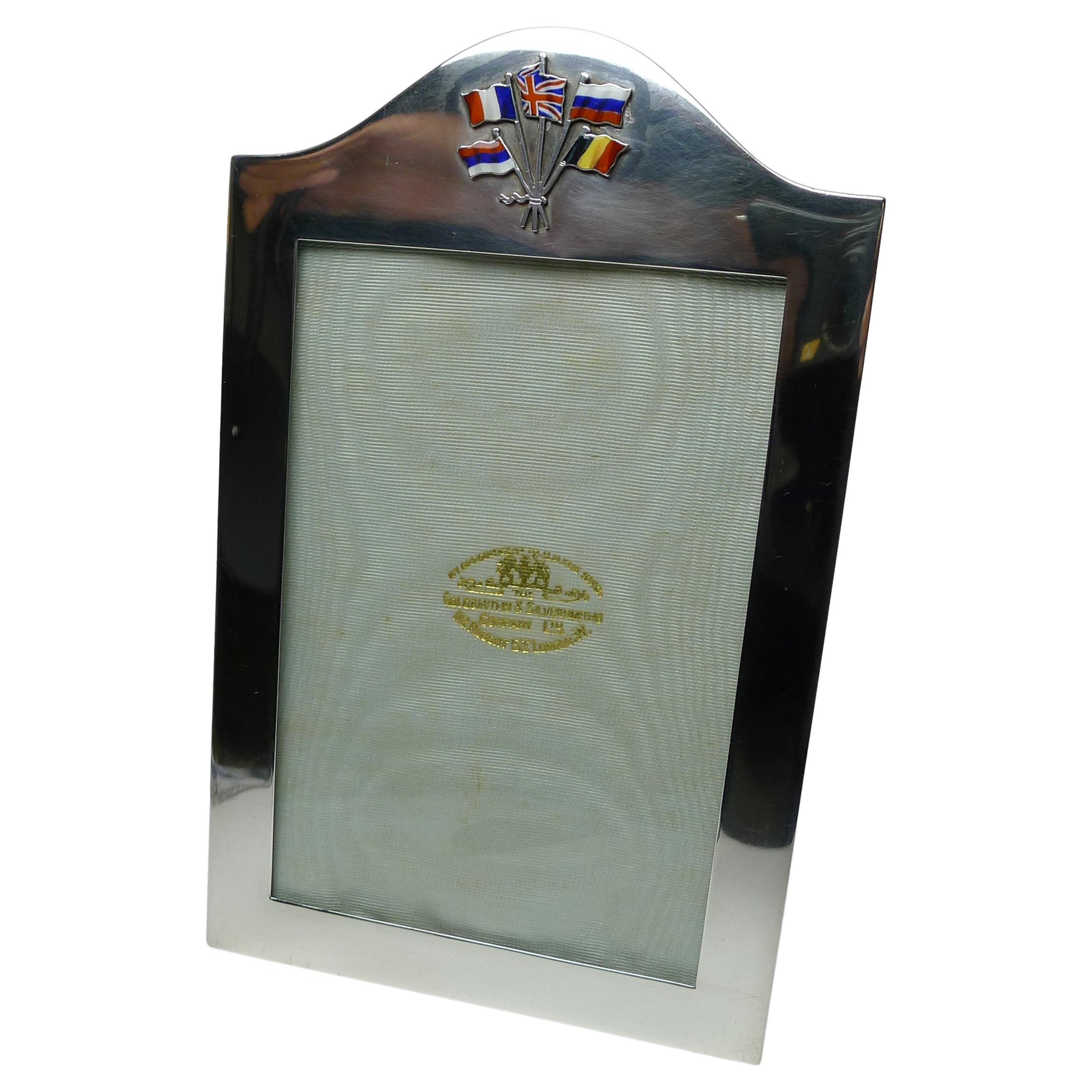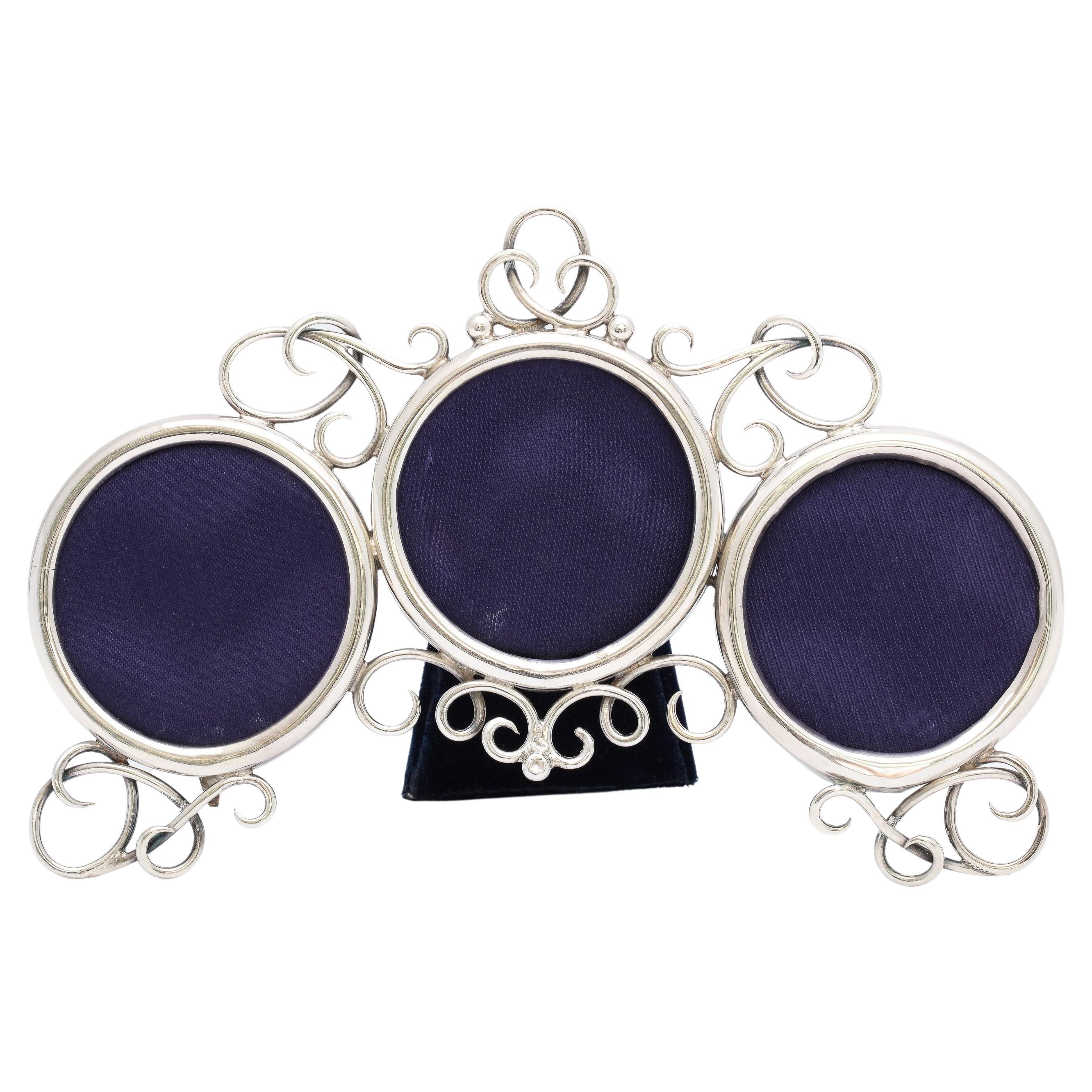Items Similar to rare Silver picture frame, Bezalel School Jerusalem, Zeev Raban, Israel, Jewish
Want more images or videos?
Request additional images or videos from the seller
1 of 8
rare Silver picture frame, Bezalel School Jerusalem, Zeev Raban, Israel, Jewish
About the Item
This is an important and super rare picture frame, all hand made from silver, by the way the work was done and by the design it was hand made by Zeev Raban, in the last picture you can see his exactly identical design that he made for the illustrated book for "Shir Hashirim" or "The Song of Songs", this example is marked on the base part Bezalel Jerusalem in Hebrew and the back part is made from blue leather which is opened to replace the picture, inside the frame there is a dated picture to the 40s but we assume it was made earlier than that, the lower part is decorated with the word Israel, but its not the state of Israel, its the land of Israel which was the jewish name of Palestine during the English mandate.This frame is surely a one of a kind and all hand made. the back part is a bit worn as can be expected from a 100 years old object that was used.
Ze’ev Raban (22 September 1890 – 19 January 1970), born Wolf Rawicki (Ravitzki), was a Leading painter, decorative artist, and industrial designer of the Bezalel school style, and Was one of the founders of the Israeli art world.
Wolf Rawicki (later Ze'ev Raban) was born in Łódź, Congress Poland, and began his Studies there. He continued his studies in sculpture and architectural ornamentation at a Number of European art academies. These included, in 1905, the School of Applied Art in Munich at the height of the Jugendstil movement; in 1907, the neo-classical studio of Marius-Jean-Antonin Mercié at the École des Beaux-Arts in Paris; the Académie Royale Des Beaux-Arts in Brussels, then a center of Art Nouveau, under symbolist and idealist Artists Victor Rousseau and Constant Montald; and in 1912 he left Europe, joining the Bezalel School of Art in Jerusalem
Two years after following Schatz's call, Raban joined the faculty of the Bezalel school.
Here he headed the Repoussé Department, taught anatomy and composition, painting And sculpture. Raban also became director of the Graphics Press and the Industrial Art Studio. In 1914 his designs constituted the majority of the works created in the Bezalel Workshop. Raban taught at Bezalel until the school had to close down in 1929 due to Financial difficulties.
Raban is regarded as a leading member of the Bezalel school art style, in which artists Portrayed both Biblical and Zionist themes in a style influenced by the European Jugendstil (similar to Art Nouveau) and by traditional Persian and Syrian styles.
Like other European art nouveau artists of the period, such as Alphonse Mucha, Raban Combined commercial commissions with uncommissioned paintings.
"Raban easily navigated a wealth of artistic sources and mediums, borrowing and Combining ideas from East and West, fine arts and crafts from past and present. His Works blended European neoclassicism, Symbolist art and Art Nouveau with oriental Forms and techniques to form a distinctive visual lexicon. Versatile and productive, he Lent this unique style to most artistic mediums, including the fine arts, illustration, Sculpture, repousee, jewellery design, and ceramics.
- Dimensions:Height: 8.2 in (20.83 cm)Width: 5.7 in (14.48 cm)Depth: 0.5 in (1.27 cm)
- Style:Jugendstil (In the Style Of)
- Materials and Techniques:
- Place of Origin:Israel
- Period:
- Date of Manufacture:1930s
- Condition:Wear consistent with age and use. Very good condition, no brakes, repairs or dents, some light scratches and minor wear to the leather fabric part in the back.
- Seller Location:Tel Aviv - Jaffa, IL
- Reference Number:1stDibs: LU8130235524062
About the Seller
No Reviews Yet
Vetted Seller
These experienced sellers undergo a comprehensive evaluation by our team of in-house experts.
1stDibs seller since 2023
- ShippingRetrieving quote...Ships From: Tel Aviv - Jaffa, Israel
- Return PolicyThis item cannot be returned.
More From This SellerView All
- Important Early 20th Century Silver Kiddush Goblet by Bezalel School JerusalemLocated in Tel Aviv - Jaffa, ILImportant Handmade sterling silver Kiddush goblet by Bezalel School, Jerusalem, circa 1910-1913. On round base decorated with silver filigree and Cabouchon shaped green agate applications. The base fitted with Bezalel mark. The upper portion is all adorned with amazing filigree work, the base and the actual cup adorned with swirling filigree designs, in the middle there are 3 roundels, made in another technique of hammered silver, similar to the works that were produced in this time all over Europe, in the middle of each roundel there is a perfectly centered Cabouchon green agate. This work is attributed to Yehia Yemini. The goblet is marked on the base, with the earliest silver mark of the school that just say "Bezalel" in Hebrew. Yehia Yemini : Was one of the biggest and must famous Bezalel silver...Category
Early 20th Century Israeli Jugendstil Sterling Silver
MaterialsSilver
- Important Early 20th Century Silver Kiddush cup by Bezalel School JerusalemLocated in Tel Aviv - Jaffa, ILImportant Handmade sterling silver Kiddush goblet by Bezalel School, Jerusalem, Circa 1910-1913. On the cup there are 3 identical scenes of flanked lions and on the middle of them There are two columns with a staircase, this design is probably taken from Eastern European torah ark, on the middle part there is a chandelier with 3 tiger/lioness Heads, the top of the cup has 3 inscription on top of each flanking lions scene, first One says : ״כוס ישועות אשא״ (Psalms 116:13) which means " I will take the cup of Salvation", this is a rather common blessing on kiddush cups. Next inscription says : ״אין שמחה אלא ביין״ in English " there is no joy except in wine" This says that after the temple was destroyed we have our joy only in the wine of Kiddish. The last inscription says ״ושמחת בחגך״ (Deuteronomy 16:14 ) in English : "And you shall rejoice in your festival". So this cup is a kiddish cup...Category
Vintage 1910s Israeli Art Nouveau Sterling Silver
MaterialsSilver
- Early 20th Century Silver Spice Tower by Yehia Yemini, Bezalel School JerusalemLocated in Tel Aviv - Jaffa, ILVery rare Bezalel Jerusalem silver filigree spice tower, this amazing spice Tower was Made by Yehia Yemini, who was the best filigree artist in bezal...Category
Vintage 1920s Israeli Sterling Silver
MaterialsSilver
- Rare early Bezalel Jerusalem JUDAICA etched brass garden of eden plateLocated in Tel Aviv - Jaffa, ILvery rare Bezalel Jerusalem plate , this amazing plate has the best subject And artistic Design i have seen in a lot of years, the plate has 5 different scenes from the story Of Adam...Category
Vintage 1910s Israeli Arts and Crafts Decorative Dishes and Vide-Poche
MaterialsBrass
- Important and rare jewish silver Sivlonot /wedding belt, Frankfurt 1707-1723Located in Tel Aviv - Jaffa, ILImportant and rare Sivlonot belt, gilded silver, made by the famous silversmith Johann Mathias Sandrat active in 1707-1723 in Frankfurt, Germany. this JUDAICA object is a museum piece and An almost identical belt with a replaced buckle is exhibited in the Israel museum and came from the important Feuchtwanger Collection, purchased and donated by Baruch and Ruth Rappaport, Geneva. the belt also bears 2 Christies auction stickers with the number 120, probably lot # 120, indicating it was sold in one of their auction rooms at some point. Sivlonot (wedding) belt: In Rabbinic literature, sivlonot refers to gifts the groom gave his wife-to-be. Among German Jews...Category
Antique Early 18th Century German Sterling Silver
MaterialsGold Plate, Silver
- extremely rare Algerian Judaica silver, jewish Dowry box early 19th centuryLocated in Tel Aviv - Jaffa, ILAmazing and scarce JUDAICA object, we have here one of the most touching jewish objects we had for a long time, this small silver dowry box was made in Algeria in the early 19th century, it is all covered with symbols of jewish faith and of couples, the sliding lid has 2 flanking birds with hamsa (protective hand) on each side and a flower vase in the middle. one side shows two flanking lions with a tree in the middle and the other side shows again two big and two small birds with a flower bowl in the middle, front side has a key hole and next to it there is the Hebrew inscription ס״ט״" which says Siman tov or in English "a good sign" it is taken from the wedding blessing, underneath the lock there is another inscription with the name ״עזיזה בת אברהם בן חמו״ which is the name of the bride, her father and her grandfathers name. the box is full marked a lot of times with the silversmith mark, every side of the box is marked. this box was probably ordered by the grooms family to hold the jewelry they are giving to the bride as dowry, this type of objects are rare and there are just a few of them on museum collections. DOWRY (Heb. נְדֻנְיָה), the property a wife brings to her husband at marriage; the Yiddish equivalent, nadn, is from the same root. The custom of nedunyah became clearly defined and institutionalized only in the talmudic period. In biblical times, mohar (מֹהַר), whereby the groom bought his wife from her father (Gen. 24:53; Ex. 22:15–16; Hos. 3:2), was the accepted practice. It was then customary that the groom give the bride gifts, and that she bring certain property to her husband's home upon marriage: slaves, cattle, real estate, etc. (cf. Gen. 24:59–61; 29; Judg. 1:14ff.; I Kings 9:16). Evidence of the custom of nedunyah is to be found in Tobit (7:14; 8:21) and in the Assuan papyri (Cowley, Aramaic, nos. 15, 18). Gradually, mohar was superseded by the ketubbah custom according to which the husband merely assumed the responsibility of compensation to his wife in case he divorced her: he had to pay her 200 zuzim if she had been a virgin at the time of marriage, and 100 zuzim if a widow or divorcée (see *Ketubbah). By talmudic times, the institution of nedunyah was prevalent; the father gave a dowry to the bride since the daughter was excluded from paternal inheritance. Fifty zuzim (equivalent to the worth of 180 grams of silver) was the minimum amount a father was obliged to give to his daughter (Ket. 6:5). Parents usually gave much more, according to their social standing. Community funds provided the dowry for an orphan or a very poor girl (ibid.; cf. Sh. Ar., YD 251:8). In case of her father's death, the brothers of a minor girl were obliged to give her the minimum dowry, and the court estimated how much her father would have given her above the minimum dowry. The sum was then taken out of the father's estate and given to the daughter upon majority (Ket. 6:6; 68a–69b). In the absence of such an estimate, each daughter was entitled to receive one-tenth of the value of her father's estate in money, or in valuables (Yad, Ishut, 20:4–7; Sh. Ar., EH 113:4). If the father was unable or unwilling to pay the promised dowry at the betrothal ceremony, the groom could refuse to marry his bride (Ket. 13:5; Ket. 108b–109a). Insistence on exact payment of the promised dowry, however, was frowned upon by later rabbinic authorities (Rema to Sh. Ar., EH 2:1). In certain communities it was customary for the groom's father to make a dowry contribution equal to that of the bride's father (Ket. 102b). The dowry, whether given in real estate, slaves, money, or chattel was recorded in the marriage contract (the ketubbah) and in some instances one-third or one-fifth of the actual value of the dowry was added to the sum mentioned in the ketubbah. Based upon a decree enacted by *Simeon b. Shetah (first century C.E.), the Talmud ruled that the husband and his entire property were liable for compensation as stipulated in the ketubbah, either in case he died (when she collected the sum specified in the ketubbah from the heirs) or in case he divorced his wife (Ket. 82b). For the status of the dowry and the husband's rights and obligations, see below. The rabbinic enactments (Takkanot Shum) by R. Jacob *Tam and by the rabbinic synod of the communities of Speyer, Worms, and Mainz (Germany) stipulated that if a woman died...Category
Antique Mid-19th Century Algerian Tribal Art
MaterialsSilver
You May Also Like
- Behrens School German Secessionist Picture Frame in Ebonized OakLocated in New York, NYGerman secessionist carved and ebonized oak picture frame made by a follower of Behrens. The piece was likely made during the 1910s and has an anti...Category
Vintage 1910s German Jugendstil Picture Frames
MaterialsGlass, Oak
- Modern Sterling Taxco School Picture FrameLocated in West Palm Beach, FLModern Sterling Taxco School Picture Frame Mexico, circa 1960s With a continuous surround of repoused flower-heads Supported on a beautifully crafted har...Category
20th Century Modern Picture Frames
MaterialsSterling Silver
- Sterling Silver Picture FrameLocated in New York, NYA sterling silver picture frame with decorative edge, circa early-20th century. Marked 'Sterling' on back as shown in close-up image, last image. Dimensions: 3.5" Width x 4" Height.Category
Early 20th Century Picture Frames
MaterialsSterling Silver
- Sterling Silver Picture FrameLocated in New York, NYLarge, sterling silver, wood-backed picture frame, Birmingham, England, 1921, Gulienetti and Co., Ltd. - makers. Measures 10 inches high (at highest point) x 8 inches wide at widest ...Category
Vintage 1920s English Edwardian Sterling Silver
MaterialsSterling Silver
- Rare English Silver & Enamel Picture Frame, Allies of 1914By Goldsmiths & Silversmiths Co. Ltd.Located in Bath, GBA magnificent and rare English sterling silver photograph frame by the top notch silversmith, Goldsmiths and Silversmiths Company L...Category
Vintage 1910s European Picture Frames
MaterialsEnamel, Sterling Silver
- Rare Victorian Sterling Silver Scrolled Wire Triple Picture FrameBy E. Mander & Son LtdLocated in New York, NYUnusual, rare, Victorian period, scrolled wire triple picture frame, Birmingham, England, year-hallmarked for 1899, E. Mander and Son, Ltd. - make...Category
Antique 1890s English Victorian Picture Frames
MaterialsSterling Silver
Recently Viewed
View AllMore Ways To Browse
French Gilded Bronze Picture Frames
Tiffany Frame Bronze
Green Barovier Frame
Triple Silver Picture Frame
Gold Picture Frame 5x7
Hunter And Hounds
One Stand Circular Dining Table
Vintage Opal Glass Sconces
Neils O Moller Dining Chairs
Pair Bubble Glass Flush
French Tortoise Table
French Wooden Chair With Fabric Back And Seat
Mid Century Modern Martini Glasses
Mirrors Gold Leaf Decorative Crafts
5m Dining Table
Tiny Vanity
Travel Perfume Case Vintage
Irregular Gold Mirror
